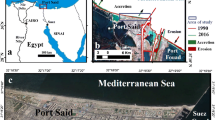Abstract
The study to generate the baseline of natural radiation and radioactivity in East and West Khasi Hills District of Meghalaya, India was conducted to determine the different radiation dose in selected stations. Twenty stations were selected in both the district, which include Shillong the capital of Meghalaya and the Domiasiat area, which has been identified as one with a Uranium ore deposit. The dose was measured using a Micro-R-Survey meter and from the measurement it was found out that the absorbed dose in both the districts ranges from 0.04 to 1.66 μGy h−1. The maximum dose was observed in Kylleng (0.72 μGy h−1) and the minimum in Mawphlang (0.06 μGy h−1). Average absorbed dose and equivalent dose were found to be higher than the Indian and world average values by several orders. The radiation levels distribution was found to be non-uniform through out the selected study area.
Similar content being viewed by others
References
Akyil, S., Erees, F. S., & Olmez, Ş. (1996). Gross a-particle activities in the ground water in western Anatolia. Applied Radiation and Isotopes, 47(7), 709–711.
Banzi, F. P., Msaki, P., & Makundi, I. N. (2002). A survey of background radiation dose rate and radioactivity in Tanzania. Health Physics, 52, 80–86.
Goddard, C. C. (2002). Measurement of outdoor terrestrial gamma radiation in the sultanate of Oman. Health Physics, 82(6), 870–874.
Hoda, S. Q. (2004). Exploration of Uranium in Meghalaya and the Environmental monitoring strategies. Proceedings of the 13th National Symposium on Environment, 33–3.
Kamath, R. R., Menon, M. R., Shukla, V. K., Sadasivan, S., & Nambi, K. S. V. (1996). Natural and fallout radioactivity measurement of Indian soils by gamma spectrometric technique. Proceedings of the 5th National Symposium on Environment, 56–0.
Karunakara, N., Somashekarappa, H. M., Avadhani, D. N., Mahesh, H. M., Narayana, Y., & Siddappa, K. (2001). Ra-226, Th-232 and K-40 distribution in the environment of Kaiga of south west coast of India. Health Physics, 80, 470–475.
Lakshmi, K. S., Catherine, S., Kavitha, M., Meenakshisundaram, V., & Iyengar, M. A. R. (1995). Study of background radiation along the east coast of Taminadu—A preliminary report. Proceedings of the 4th National Symposium on Environment, Madras, 179–83.
Malanca, A., Pessina, V., & Dallara, G. (1994). Measurement of gamma radiation in three underground scheelite mines. Journal of Environmental Radioactivity, 23, 71–80.
Nambi, K. S. V., Bapat, V. N., David, M., Sundaram, V. K., Sunta, C. M., & Soman, S. D. (1986). Natural background radiation and population dose contribution in India. Health Physics Division, B ARC, Report.
Porstendorfer, J. (1994). Properties and behavior of Radon and Thoron and their decay products in the air. Journal of Aerosol Science, 25, 219–263.
Sannappa, J., Chandrashekara, M. S., Sathish, L. A., Paramesh, L., & Venkataramaiah, P. (2003). Study of background radiation dose in Mysore City, Karnataka state, India. Radiation Measurement, 37, 55–65.
Stuart, A. (1962). Basic ideas of scientific sampling. New York: Hafner.
United Nations Scientific Committee on the Effect of Atomic Radiation (UNSCEAR). (1998). Exposures from natural sources of Radiation. United Nations, New York: Report to the General Assembly.
United Nations Scientific Committee on the Effect of Atomic Radiation (UNSCEAR). (2000). Exposures from natural sources of radiation. United Nations, New York: Report to the General Assembly.
Author information
Authors and Affiliations
Corresponding author
Rights and permissions
About this article
Cite this article
Marbaniang, D.G., Poddar, R.K. & Nongkynrih, P. Study of the variation and the effect of geo-chemical composition on the external background radiation level. Environ Monit Assess 152, 223–230 (2009). https://doi.org/10.1007/s10661-008-0310-x
Received:
Accepted:
Published:
Issue Date:
DOI: https://doi.org/10.1007/s10661-008-0310-x




